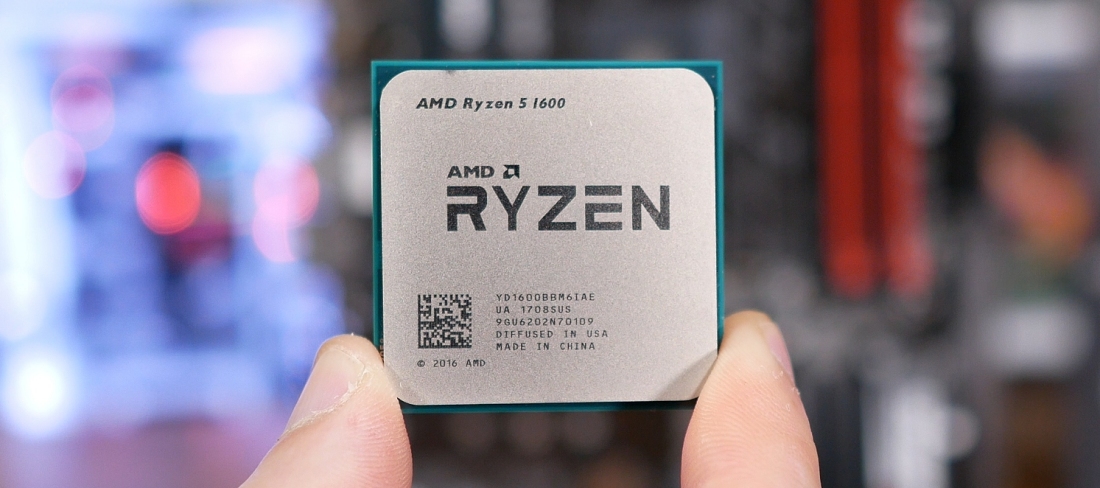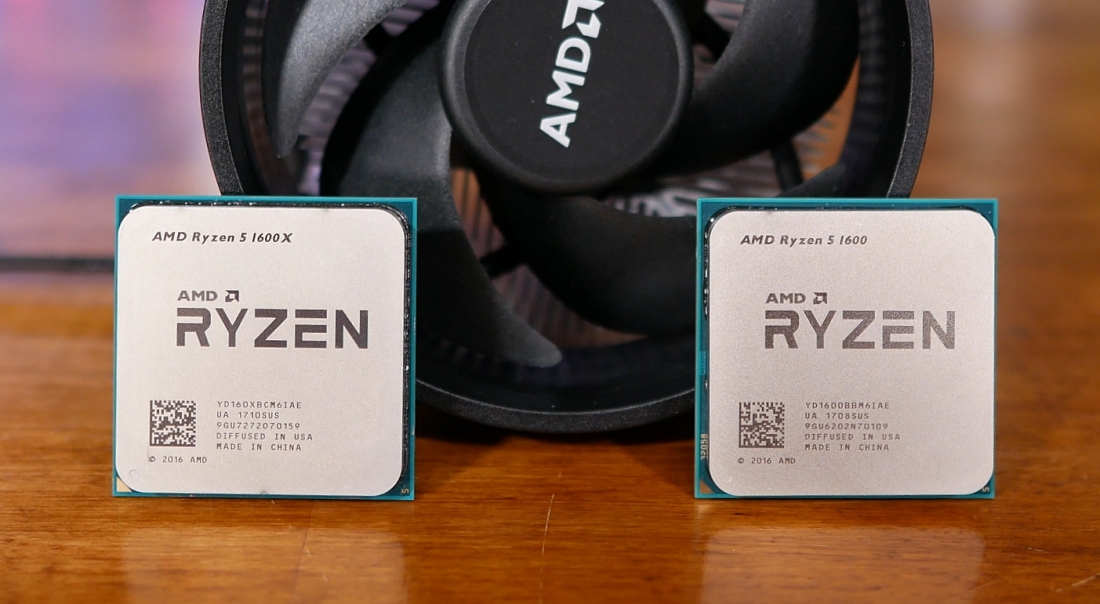The Denmarkanswer to that question may seem obvious to many of you, not least because our Ryzen 5 review said the non-X model looked like a better value. However, we didn't actually have a plain 1600 on-hand at the time, we just assumed based on what we saw with the Ryzen 7 chips that the 1600 would overclock as well, or at least nearly as well as the 1600X.
Although there isn't likely to be a dramatic performance difference between the two chips, the $220 1600 comes bundled with the 95-watt 'Wraith Spire' cooler, while the $250 1600X doesn't come with a cooler at all. If you add the cost of a basic heatsink to the 1600X, the non-X version is around 20% cheaper, yet it shouldn't be more than 10% slower out of the box.

The 'X-rated' 1600X also features "XFR" or Extended Frequency Range, which is basically a beefier version of Turbo that lets the CPU overclock itself a little harder when attributes such as power, current and thermals are within acceptable ranges. XFR is enabled by default on 'X' model Ryzen CPUs, though it's disabled when manually overclocking.
The 1600X has a base clock speed of 3.6GHz, a boost clock of 4.0 GHz and a maximum XFR boost speed of 4.1GHz. However those figures are a little misleading.
For example, boost frequencies will only allow the 1600X to hit 4 - 4.1GHz for single-threaded workloads, whereas the CPU won't actually boost higher than 3.7GHz on multi-threaded workloads, or a mere 3% increase over the base clock.
The 1600 on the other hand operates at a base clock frequency of just 3.2GHz and is advertised to boost as high as 3.6GHz, though again that boost frequency will only be achieved when taxing a single core. However, despite advertising a boost speed of 3.6GHz, stressing a single core in most cases also sees the 1600 exhibit XFR-like gains, allowing it to reach 3.7GHz. Interestingly, it seems like all Ryzen CPUs feature XFR.

The 1600's maximum multi-thread frequency is 3.4GHz, which suggests that for heavy workloads it will only be clocked 8% lower than the 1600X. Of course, these figures will be different if you manually overclock, which is certainly worth considering given that Ryzen CPUs are unlocked and the 1600 can be pushed quite hard with the Wraith Spire box cooler.
We can already say that if you don't plan to overclock, the 1600X is the faster CPU while the 1600 is the better value as it can't be more than 10% slower and yet it's at least 20% less expensive thanks to the included box cooler and lower MSRP.
However, we aren't sure if that story remains true when overclocking, especially if the 1600X offers more headroom. Rumor is, the X-models are capable of greater frequencies and we've seen some evidence of this with the 1700X and 1700, though for the most part the margins were thin.
The 1600X chip we have on-hand for testing had no trouble hitting 4.1GHz at just 1.38 volts and it was even possible to benchmark the system at 4.2GHz after increasing the voltage to 1.5, but AMD recommends a maximum of 1.45 volts for sustained use.
Set at the same 1.38 volts, the 1600 reached 4GHz – not bad – and increasing the voltage a fraction more to 1.4 allowed us to achieve a stable overclock of 4050MHz, only 50MHz shy of what the 1600X managed.

Of course, this could have very easily been around the other way. I just happened to receive a good 1600X. I've seen plenty of reviewers and now users limited to 4GHz with the 1600X, so as always with overclocking, your mileage will vary (4GHz does seem nearly guaranteed, though).
For single-threaded workloads, the manual overclock won't actually be any faster than the stock 4.1GHz XFR performance, but multi-threaded performance should be up to 11% faster for the 1600X and 21% faster for the 1600.
Before moving on, we should note that this isn't an in-depth Ryzen 5 1600 review – in fact, it's not really a review at all. That will come later along with coverage of the quad-core 1400 model.
Instead, we thought it would be interesting to take a detailed look at the performance differences between AMD's six-core Ryzen 5 processors, assuming you're lucky enough to be in the market for a new CPU priced between $200 and $250.
 Apple Store employee accused of sending himself photos from customer's phone
Apple Store employee accused of sending himself photos from customer's phone
 Next year's Apple Watch might be suitable for diving
Next year's Apple Watch might be suitable for diving
 Florence and the Machine's Opera House show fined for being too loud
Florence and the Machine's Opera House show fined for being too loud
 Waitin’ on the Student Debt Jubilee
Waitin’ on the Student Debt Jubilee
 Madonna reminds angry fans: 'A queen is never late'
Madonna reminds angry fans: 'A queen is never late'
 Uber CEO downplays murder of Jamal Khashoggi as 'mistake,' then backtracks
Uber CEO downplays murder of Jamal Khashoggi as 'mistake,' then backtracks
 Madonna reminds angry fans: 'A queen is never late'
Madonna reminds angry fans: 'A queen is never late'
 This fat bear's before and after photos are stunning
This fat bear's before and after photos are stunning
 'Rick and Morty' Season 4 cements a big power shift: Review
'Rick and Morty' Season 4 cements a big power shift: Review
 'The Last of Us' Season 2, episode 4: Why Ellie sings 'Take on Me'
'The Last of Us' Season 2, episode 4: Why Ellie sings 'Take on Me'
 Photos show the devastating impact of eastern Australia's bushfires
Photos show the devastating impact of eastern Australia's bushfires
 Instagram experiment hits the U.S., and your likes may disappear soon
Instagram experiment hits the U.S., and your likes may disappear soon
 Why Extinction Rebellion dropped a sinking house in the River Thames
Why Extinction Rebellion dropped a sinking house in the River Thames
 Today's Hurdle hints and answers for May 9, 2025
Today's Hurdle hints and answers for May 9, 2025
 Facebook bug secretly turns on iPhone camera
Facebook bug secretly turns on iPhone camera
 You can now remove things from Facebook's shortcut bar, including the red dots
You can now remove things from Facebook's shortcut bar, including the red dots
 What the critics are saying about Disney+'s 'The Mandalorian'
What the critics are saying about Disney+'s 'The Mandalorian'
 Samsung Unpacked stream is set for May 12, 2025
Samsung Unpacked stream is set for May 12, 2025
 Sonos speakers now work with the free version of Spotify
Sonos speakers now work with the free version of Spotify
PewDiePie explains ISIS tweet that got him temporarily kicked off TwitterNYC real estate startup Compass is now worth $1 billionStarbucks has a spicy new fall drink to challenge the beloved PSLGermany vs. Portugal 2025 livestream: Watch UEFA Nations League semi final for freeIndia's newest 4G carrier Reliance Jio shakes up the entire countryMexican president says he told Trump that Mexico won't pay for the wall'Moulin Rouge!' stage musical in developmentThe futuristic Lenovo Yoga Book can digitize your paper notesCalvin Harris uses someone else's birthday to remind you he works outIndia's newest 4G carrier Reliance Jio shakes up the entire countryThis little dog is a bigger soccer fan than youA European satellite got hit by some kind of space debrisAlcatel's Vision VR headset doesn't need a phoneBest Nintendo Switch 2 deals: Save on cases, accessories, and moreHurricane Madeline poised for 'dangerously close' encounter with Big Island of HawaiiAsus ZenBook 3 looks just like a MacBook, except it runs Windows 10Samsung's 88Why we should worry about Facebook's Trending topics disasterSuper fun Force Band gives you JediSuper fun Force Band gives you Jedi Reappearing Women: A Conversation Between Marie Darrieussecq and Kate Zambreno by The Paris Review On Edward Lear’s “The Scroobious Pip” What Once Was Lost: Unfinding and Refinding Music History Feeling Foreign: An Interview with Hernan Diaz The Renaissance Precursor of Rap Battles and Flow Barney’s Wall: An Evening with Barney Rosset and ‘The Paris Review’ The Electrifying Dreamworld of ‘The Green Hand’ Happy Accidents Ghost Club: Yeats’s and Dickens’s Secret Society of Spirits The Case for Seasonal Sentimentality by Mary Laura Philpott The Ruin: Roosevelt Island’s Smallpox Hospital Evil, “Venerable,” and Otherwise: An Interview with Barbet Schroeder Time Marches On: An Interview with Jon McGregor Staff Picks: Cats, Combat, Conversationalists The Pound Poem That Wasn't By Pound George Plimpton on ‘Playboy After Dark’ With a Bang: An Interview with Eleanor Antin The Hollywood Darling Who Tanked His Career to Combat Anti Redux: Joan Didion, William Faulkner, and Matthew Zapruder When Someone You Know is Gay